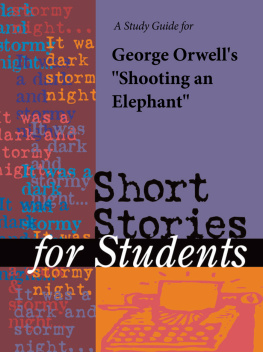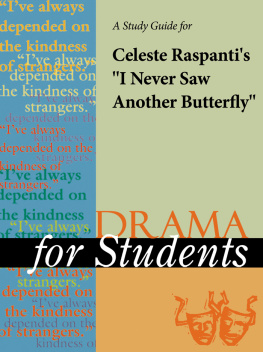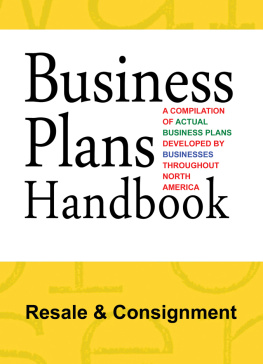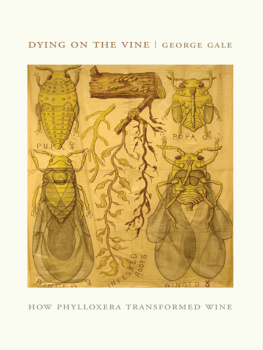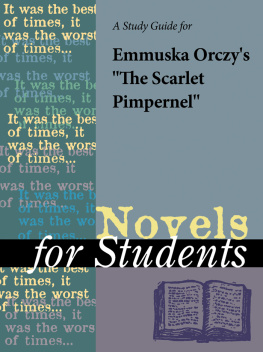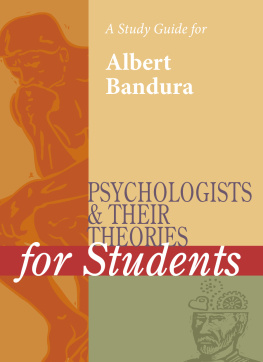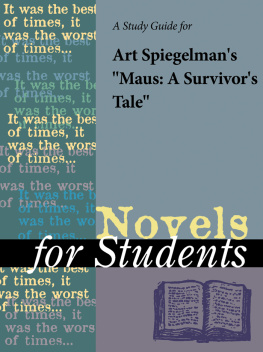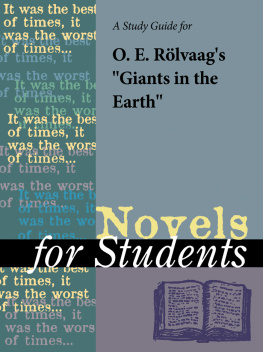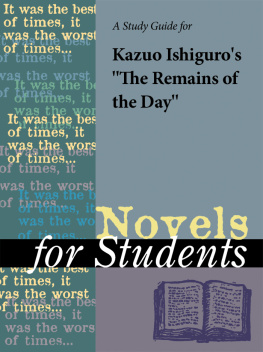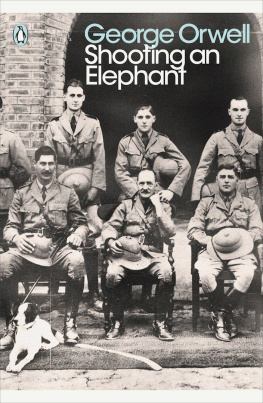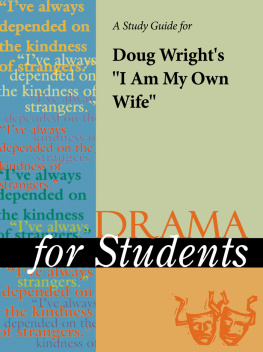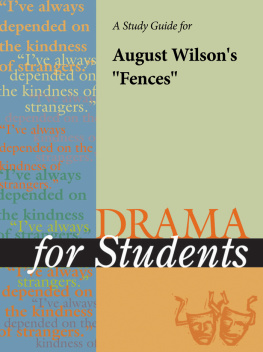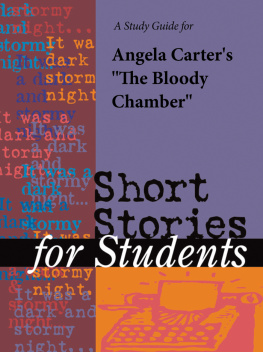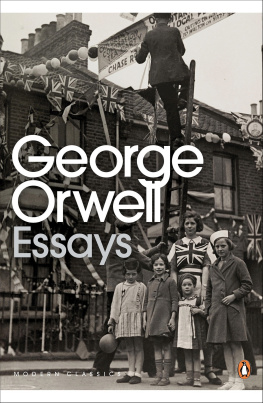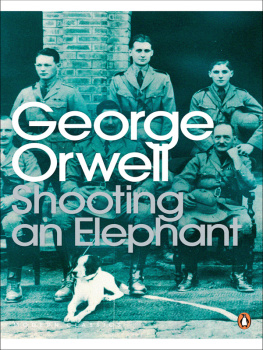Gale - A Study Guide for George Orwells Shooting an Elephant
Here you can read online Gale - A Study Guide for George Orwells Shooting an Elephant full text of the book (entire story) in english for free. Download pdf and epub, get meaning, cover and reviews about this ebook. year: 2015, publisher: Gale, Cengage Learning, genre: Romance novel. Description of the work, (preface) as well as reviews are available. Best literature library LitArk.com created for fans of good reading and offers a wide selection of genres:
Romance novel
Science fiction
Adventure
Detective
Science
History
Home and family
Prose
Art
Politics
Computer
Non-fiction
Religion
Business
Children
Humor
Choose a favorite category and find really read worthwhile books. Enjoy immersion in the world of imagination, feel the emotions of the characters or learn something new for yourself, make an fascinating discovery.
- Book:A Study Guide for George Orwells Shooting an Elephant
- Author:
- Publisher:Gale, Cengage Learning
- Genre:
- Year:2015
- Rating:3 / 5
- Favourites:Add to favourites
- Your mark:
- 60
- 1
- 2
- 3
- 4
- 5
A Study Guide for George Orwells Shooting an Elephant: summary, description and annotation
We offer to read an annotation, description, summary or preface (depends on what the author of the book "A Study Guide for George Orwells Shooting an Elephant" wrote himself). If you haven't found the necessary information about the book — write in the comments, we will try to find it.
Gale: author's other books
Who wrote A Study Guide for George Orwells Shooting an Elephant? Find out the surname, the name of the author of the book and a list of all author's works by series.
A Study Guide for George Orwells Shooting an Elephant — read online for free the complete book (whole text) full work
Below is the text of the book, divided by pages. System saving the place of the last page read, allows you to conveniently read the book "A Study Guide for George Orwells Shooting an Elephant" online for free, without having to search again every time where you left off. Put a bookmark, and you can go to the page where you finished reading at any time.
Font size:
Interval:
Bookmark:


Staff
Editorial: Kathleen Wilson, Marie Lazzari, Editors. Greg Barnhisel, Thomas Bertonneau, Cynthia Bily, Paul Bodine, Julia Burch, Yoonmee Chang, John Chua, Carol DellAmico, Catherine Dominic, Mark Elliot, Terry Girard, Rena Korb, Rebecca Laroche, Sketchwriters. Suzanne Dewsbury, James Person, Contributing Editors. Aarti Stephens, Managing Editor
Research: Victoria B. Cariappa, Research Manager. Andrew Malonis, Research Specialist.
Permissions: Susan M. Trosky, Permissions Manager. Kimberly Smilay, Permissions Specialist. Kelly Quin, Permissions Associate.
Production: Mary Beth Trimper, Production Director. Evi Seoud, Assistant Production Manager. Shanna Heilveil, Production Assistant
Graphic Services: Randy Bassett, Image Database Supervisor. Mikal Ansari, Robert Duncan, Imaging Specialists. Pamela A. Reed, Photography Coordinator.
Copyright Notice
Since this page cannot legibly accommodate all copyright notices, the acknowledgments constitute an extension of the copyright notice.
While every effort has been made to secure permission to reprint material and to ensure the reliability of the information presented in this publication, Gale Research neither guarantees the accuracy of the data contained herein nor assumes any responsibility for errors, omissions, or discrepancies. Gale accepts no payment for listing; and inclusion in the publication of any organization, agency, institution, publication, service, or individual does not imply endorsement of the editors or publisher. Errors brought to the attention of the publisher and verified to the satisfaction of the publisher will be corrected in future editions.
This publication is a creative work fully protected by all applicable copyright laws, as well as by misappropriation, trade secret, unfair competition, and other applicable laws. The authors and editors of this work have added value to the underlying factual material herein through one or more of the following: unique and original selection, coordination, expression, arrangement, and classification of information. All rights to this publication will be vigorously defended.
Copyright 1998
Gale Research
835 Penobscot Building
645 Griswold
Detroit, MI 48226-4094
All rights reserved including the right of reproduction in whole or in part in any form.
This book is printed on acid-free paper that meets the minimum requirements of American National Standard for Information SciencesPermanence Paper for Printed Library Materials, ANSI Z39.48-1984.
ISBN 0-7876-2219-2
ISSN 1092-7735
Printed in the United States of America
10 9 8 7 6 5 4 3 2 1

George Orwell
1936
George Orwells Shooting an Elephant first appeared in 1936. The British public already knew Orwell as the socially conscious author of Down and Out in London and Paris (1933), a nonfiction study of poverty, homelessness, unemployment, and subsistence living on poorly-paying menial jobs, and Burmese Days (1934), a novel of British colonialism. Shooting an Elephant functions as an addendum to Burmese Days. The story and novel share the same setting, and draw on Orwells experience as a colonial official in India and Burma, two regions of the British Empire, in the middle of the century between the two world wars. The story (which some critics consider an essay) concerns a colonial officers obligation to shoot a rogue elephant. The narrator does not want to shoot the elephant, but feels compelled to by a crowd of indigenous residents, before whom he does not wish to appear indecisive or cowardly. The situation and events that Orwell describes underscores the hostility between the administrators of the British Empire and their native subjects. Both sides feel hatred, distrust, and resentment. The situation is universally degrading. The shooting itself involves enormous pathos conveyed economically in a few words.
Shooting an Elephant is a central text in modern British literature and has generated perhaps more criticism than any other comparable short piece. In the politicized atmosphere of contemporary criticism, commentators are especially drawn into debate about whether Orwell apologizes for or condemns imperialism. Left-wing critics see insufficient condemnation; conservative critics point out that it is the narrator, an agent of empire, who explicitly denounces the British presence as pervasively corrupting to both sides. The story is one of the most widely anthologized and studied items of the modern English-language canon.
George Orwell was born Eric Blair on June 25, 1903, in Motihari, Bengal, which was then a province of India under British rule. Richard Blair, Orwells father, was a British government official. Sent back to England for his education, Orwell attended St. Cyprians, Wellington College, and then Eton. After graduating, Orwell joined the Indian Imperial Police, from which he resigned in 1927, having in the meantime settled on writing as a career.
Interested in the life of the lower classes and the poor, Orwell lived in working-class neighborhoods in Paris and London in 1928 and 1929, collecting material that he would eventually publish, after many rejections (including one from T. S. Eliot), as Down and Out in Paris and London, under the pen-name George Orwell, in 1933. In the interval, Blair wrote essays, poetry, and journalism, including the drafts of Burmese Days, which also appeared in 1933. A series of novels followed, all under his new pen-name, with which he increasingly identified himself. He published A Clergymans Daughter in 1935, Keep the Aspidistra Flying in 1936, The Road to Wigan Pier in 1937, and Coming up for Air in 1939, just before the outbreak of the war that the book predicted. Orwell fought in the Spanish Civil War on the Republican side. His motive was to fight against Fascism, represented by Francos anti-Republican Falange Party. Orwell soon became disillusioned with the Republican side, however, seeing the hand of Stalins KGB everywhere in its increasingly corrupt and ineffective policies. He published an account of his Spanish experience in the booklength essay Homage to Catalonia in 1938.
Orwell worked for the British Broadcasting Corporation (BBC) during World War II while working on the two novels for which he remains best known, Animal Farm (1944), a satire of Stalinism and of coercive collectivism in general, and 1984, published in 1949, a bleak depiction of a world entirely subjugated to a totalitarian regime. In addition, he wrote essays and journalistic and broadcast pieces, and was active throughout the war on behalf of the Allied military effort.
Orwell had contracted tuberculosis in the 1920s. Overwork during the war years exacerbated his condition, and he became ill shortly after completing the manuscript of 1984. He married his second wife while in the hospital, and was planning a trip to Switzerland to recuperate when he died of pulmonary edema on January 26, 1950.
Font size:
Interval:
Bookmark:
Similar books «A Study Guide for George Orwells Shooting an Elephant»
Look at similar books to A Study Guide for George Orwells Shooting an Elephant. We have selected literature similar in name and meaning in the hope of providing readers with more options to find new, interesting, not yet read works.
Discussion, reviews of the book A Study Guide for George Orwells Shooting an Elephant and just readers' own opinions. Leave your comments, write what you think about the work, its meaning or the main characters. Specify what exactly you liked and what you didn't like, and why you think so.

